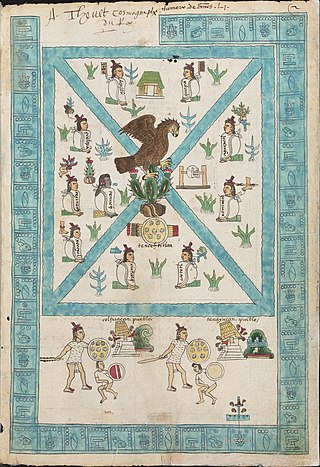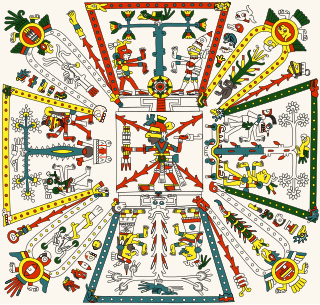
The Codex Mendoza is an Aztec codex, believed to have been created around the year 1541. It contains a history of both the Aztec rulers and their conquests as well as a description of the daily life of pre-conquest Aztec society. The codex is written using traditional Aztec pictograms with a translation and explanation of the text provided in Spanish. It is named after Don Antonio de Mendoza (1495-1552), the viceroy of New Spain, who supervised its creation and who was a leading patron of native artists.

The Dresden Codex is a Maya book, which was believed to be the oldest surviving book written in the Americas, dating to the 11th or 12th century. However, in September 2018 it was proven that the Maya Codex of Mexico, previously known as the Grolier Codex, is, in fact, older by about a century. The codex was rediscovered in the city of Dresden, Germany, hence the book's present name. It is located in the museum of the Saxon State Library. The codex contains information relating to astronomical and astrological tables, religious references, seasons of the earth, and illness and medicine. It also includes information about conjunctions of planets and moons.

The Papyrus of Ani is a papyrus manuscript in the form of a scroll with cursive hieroglyphs and colour illustrations that was created c. 1250 BCE, during the Nineteenth Dynasty of the New Kingdom of ancient Egypt. Egyptians compiled an individualized book for certain people upon their death, called the Book of Going Forth by Day, more commonly known as the Book of the Dead, typically containing declarations and spells to help the deceased in their afterlife. The Papyrus of Ani is the manuscript compiled for the Theban scribe Ani; it is now in the British Museum.

Eight Deer Jaguar Claw, or Eight Deer for brevity, was a powerful Mixtec ruler in 11th-century Oaxaca referred to in the 15th-century deerskin manuscript Codex Zouche-Nuttall, and other Mixtec manuscripts. His surname is alternatively translated Tiger-Claw and Ocelot-Claw. John Pohl has dated his life spanning from 1063 until his assassination in 1115.

The Codex Zouche-Nuttall or Codex Tonindeye is an accordion-folded pre-Columbian document of Mixtec pictography, now in the collections of the British Museum. It is one of about 16 manuscripts from Mexico that are entirely pre-Columbian in origin. The codex derives its name from Zelia Nuttall, who first published it in 1902, and Baroness Zouche, its donor.

Aztec codices are Mesoamerican manuscripts made by the pre-Columbian Aztec, and their Nahuatl-speaking descendants during the colonial period in Mexico.

The Codex Magliabechiano is a pictorial Aztec codex created during the mid-16th century, in the early Spanish colonial period. It is representative of a set of codices known collectively as the Magliabechiano Group. The Codex Magliabechiano is based on an earlier unknown codex, which is assumed to have been the prototype for the Magliabechiano Group. It is named after Antonio Magliabechi, a 17th-century Italian manuscript collector, and is held in the Biblioteca Nazionale Centrale, Florence, Italy.

Codex Ríos is an Italian translation and augmentation of a Spanish colonial-era manuscript, Codex Telleriano-Remensis, that is partially attributed to Pedro de los Ríos, a Dominican friar working in Oaxaca and Puebla between 1547 and 1562. The codex itself was likely written and drawn in Italy after 1566.

The Codex Borgia, also known as Codex Borgianus, Manuscrit de Veletri and Codex Yohualli Ehecatl, is a pre-Columbian Middle American pictorial manuscript from Central Mexico featuring calendrical and ritual content, dating from the 16th century. It is named after the 18th century Italian cardinal, Stefano Borgia, who owned it before it was acquired by the Vatican Library after the cardinal's death in 1804.

The Codex Fejérváry-Mayer is an Aztec Codex of central Mexico. It is one of the rare Native American manuscripts that have survived the Spanish conquest of the Aztec Empire. As a typical calendar codex tonalamatl dealing with the sacred Aztec calendar – the tonalpohualli – it is placed in the Borgia Group. It is a divinatory almanac in 17 sections. Its elaboration is typically pre-Columbian: it is made on deerskin parchment folded accordion-style into 23 pages. It measures 16.2 centimetres by 17.2 centimetres and is 3.85 metres long.

The Codex Colombino is a part of a Mixtec codex held in the collection of the National Museum of Anthropology in Mexico City. It is one of only two Mesoamerican codices that remain in Mexican territory. It deals with the genealogy, marriages and bellicose conquests of the Mixtec lord Eight Deer Jaguar Claw.

The Codex Cospi is a pre-Columbian Mesoamerican pictorial manuscript, included in the Borgia Group. It is currently located in the library of the University of Bologna.

The Codex Bodley is an important pictographic manuscript and example of Mixtec historiography. It was named after the colloquial name of the Bodleian Library, where it has been stored since the 17th century.

Codex Vaticanus B, also known as Codex Vaticanus 3773, Codice Vaticano Rituale, and Códice Fábrega, is a pre-Columbian Middle American pictorial manuscript, probably from the Puebla part of the Mixtec region, with a ritual and calendrical content. It is a member of the Borgia Group of manuscripts. It is currently housed at the Vatican Library.

Codex Vindobonensis Mexicanus I, also known as Codex Vindobonensis C, or Codex Mexicanus I is an accordion-folded pre-Columbian piece of Mixtec writing. It is a ritual-calendrical and genealogical document dated to the 14th century.

The Codex Selden is a Mexican manuscript of Mixtec origin. The codex is an account of the genealogy of the Jaltepec dynasty from the tenth to the 16th century. Codex Selden is possibly a fragment of a much longer improperly stored document. Although it was completed after the arrival of the conquistadors in the Mixtec region, it is considered one of the six pre-Hispanic Mixtec codices that survived the Spanish conquest of the Aztec Empire. The last date mentioned in the Codex is 1556, which can be interpreted as the date when the codex was finished.

The Selden Roll is a 16th-century Mexican manuscript painted roll from the Coixtlahuaca region, incorporating both Mixtec and Aztec elements, probably recording myths of the origin and migration of divine ancestors.
The Verona Sacramentary or Leonine Sacramentary is the oldest surviving liturgical book of the Roman rite. It is not a sacramentary in the strict sense, but rather a private collection of libelli missarum containing only the prayers for certain Masses and not the scriptures, the canon or the antiphons. It is named after the sole surviving manuscript, Codex Veronensis LXXXV, which was found in the chapter library of the cathedral of Verona by Giuseppe Bianchini and published in his four-volume Anastasii bibliothecarii vitae Romanorum pontificum in 1735. It is sometimes called "Leonine" because it has been attributed to Pope Leo I, but while some of the prayers may be his compositions the entire work certainly is not.

Mesoamerican codices are manuscripts that present traits of the Mesoamerican indigenous pictoric tradition, either in content, style, or in regards to their symbolic conventions. The unambiguous presence of Mesoamerican writing systems in some of these documents is also an important, but not defining, characteristic, for Mesoamerican codices can comprise pure pictorials, native cartographies with no traces of glyphs on them, or colonial alphabetic texts with indigenous illustrations. Perhaps the best-known examples among such documents are Aztec codices, Maya codices, and Mixtec codices, but other cultures such as the Tlaxcaltec, the Purépecha, the Otomi, the Zapotecs, and the Cuicatecs, are creators of equally relevant manuscripts. The destruction of Mesoamerican civilizations resulted in only about twenty known pre-Columbian codices surviving to modern times.
The Akademische Druck- und Verlagsanstalt (ADEVA) is an Austrian book publisher in Graz that specialises primarily in publishing lavish facsimile editions.






















